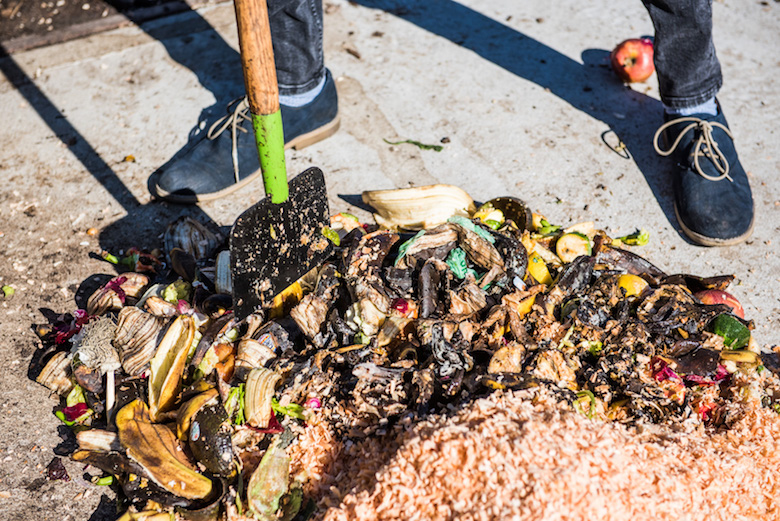
Editor’s note: We kicked off our first annual Food Loves Tech event last summer in Chelsea—here’s a recap. We’re bringing a taste of the food and farming future back this year, but just across the East River at Industry City. Leading up to the event, this story is part of an ongoing series about technology’s effects on our food supply.
Last week, I found a forgotten carton of half-and-half hiding in the back corner of my fridge. The liquid inside smelled fine, but the “best by” date had passed, so I poured it down the drain to be safe. According to Emily Broad Leib, founder and director of Harvard Law School’s Food Law and Policy Clinic, 84 percent of consumers discard food for perceived safety reasons after the date on the package has passed, even though most of those foods are perfectly safe to eat. My half-and-half was no exception.
Forty percent of food produced in the United States is wasted, and while problems in our food system abound—greenhouse gas emissions, farmworker rights, land degradation, affordable access to nutritious food—focusing on food waste is an efficient way to tackle some of our most pressing challenges. ReFED—a multi-stakeholder nonprofit committed to reducing U.S. food waste—recognizes this and have released two new tools to help do just that: the Innovator Database and the Food Waste Policy Finder.
These new tools equip leaders across sectors to identify solutions with the largest impact, and prioritize efforts to help the nation reach its goal of 50 percent reduction in food waste by 2030.
The Innovator Database profiles commercial and non-profit innovators working to transform food waste into economic, social and environmental opportunities. In New York City alone, there are about twenty-five nonprofits and commercial enterprises in the database. In Bushwick, BK ROT works at the intersection of environmental and social justice by employing local youth in a community-supported, bike-transported composting operation. Salvage Supperclub, hosts dinners in (literal) dumpsters using ingredients that would otherwise go to waste in order to raise awareness about food waste and sustainable food systems. Since 1982, City Harvest has collected over 600 million pounds of excess food from supermarkets, farmers markets, manufacturers and restaurants for delivery to soup kitchens, food pantries and community food programs throughout New York.
The Food Waste Policy Finder, developed in partnership with Harvard Law School’s Food Law and Policy Clinic, provides information about federal and state policies that address the reduction and diversion of food waste. The interactive map describes efforts to standardize or simplify date labeling, tax incentives and liability protection for food donations, restrictions on food scraps as animal feed, and state organic waste bans and recycling laws.
Date labeling on food products is almost entirely unregulated under current federal law, and states have developed an inconsistent and utterly confusing web of date labeling regulations that do a poor job of helping consumers distinguish between food safety and food quality
Date label reform is in fact one of the most cost-effective strategies to prevent food waste before it occurs, according to ReFED’s 2016 Roadmap to Reduce U.S. Food Waste. Date labeling on food products is almost entirely unregulated under current federal law, and states have developed an inconsistent and utterly confusing web of date labeling regulations that do a poor job of helping consumers distinguish between food safety and food quality. To prevent consumers from throwing their safe cartons of half-and-half away, New York does not require dates on any food products or restrict sales of expired products. The city has also taken steps to reduce the impact of food waste on landfills. As part of New York City’s goal of Zero Waste by 2030, businesses of a certain size are required separate their organic waste and the city aims to expand curbside pick-up or neighborhood drop-off of food and yard waste for all residents by 2018. Among other initiatives, there are also two new food waste bills facing the New York City council intended to mitigate street vendor food waste and create a web portal to facilitate food donations.
Both the Innovator Database and Food Waste Policy Finder tools are immensely valuable for public education and consumer waste reduction, but it is important to recognize that food waste is a structural problem that also necessitates structural solutions. Food in the U.S. is unprecedentedly cheap, agricultural subsidies encourage excess production at the farm level, and unreasonable supermarket standards for produce means food is left to rot in the fields. Solving the food waste problem will require efforts from all directions: structural policy change, private sector innovation and—thinking about that milk I poured down the drain—consumer education.



